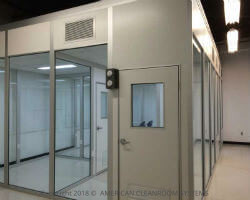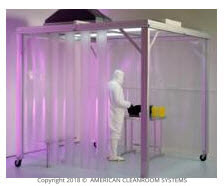A: A class 10000 cleanroom is allowed a maximum of 70 particles/ft3 greater than 5 microns and less than 10,000 particles/ft3 greater than 0.3 um. Class 10000 must have at least 60 air changes per hour. A class 1000 room is allowed a maximum of 7 particles/ft3 greater than 5 micron and less than 1000 particles/ft3 greater than 0.3 um. Class 1000 must have at least 180 air changes per hour. A Class 10000 cleanroom classification is closest to ISO-7. A class 1000 cleanroom classification is closest to ISO-6.
A: A class 100000 cleanroom is allowed a maximum of 700 particles/ft3 great than 5 microns and less than 100000 particles/ft3 great than 0.3 microns. Class 100000 must have at least 20 air changes per hour. A class 100000 cleanroom classification is closest to ISO-8
A: A class 10 cleanroom is allowed no particles greater than 5 microns, less than 10 particles/ft3 greater than 0.5 um and less than 30 particles/ft3 great than 0.3 microns. Class 10 must have more than 300 air changes per hour. A class 10 cleanroom classification is closest to ISO-4.
A: Cleanroom requirements typically refer to cleanroom classification, length, width, height, wall type, air flow of either recirculating or one pass, temperature, humidity, and room pressure. Other requirement can be related to exhaust, chemical resistance, biohazard, electrical discharge or light frequency.
A: A class 10 clean room is allowed no particles greater than 5 microns, less than 10 particles/ft3 greater than 0.5 um and less than 30 particles/ft3 great than 0.3 microns. Class 10 must have more than 300 air changes per hour. A class 10 clean room classification is closest to ISO-4.
A: ISO-9 is considered the high ISO cleanroom classification. The particle counts correspond to room and is roughly 10x as dirty as ISO-8. Class 100k is the highest FED Std 209E cleanroom classification. Class 100k is closest to ISO-8.
A: The Fed Std. 209E cleanroom classifications are class 100000 (class 100k) , class 10000 (class 10k), class 1000 and class 100. The ISO cleanroom classifications are ISO-5, ISO-6, ISO-7 and ISO-8.
A: A class 10k cleanroom is allowed a maximum of 70 particles/ft3 greater than 5 microns and less than 10,000 particles/ft3 greater than 0.3 um. Class 10k cleanroom must have at least 60 air changes per hour.
A: The ISO class of cleanroom is defined by how many particles per cubic meter and how many air changes per hour with hepa filtered air.
A: Cleanrooms are classified by particle count and HEPA filtered air changes per hour. Particle counts range from 0 to 700 particles/ft3 greater than 5 um, and air changes from 20 to 300 air changes per hour for FED Std 209E. For example a class 10,000 cleanroom is allowed 70 particles/ft3 greater than 5 microns, 10,000 particles/ft3 greater than 0.3 microns and minimum 60 air changes per hour. ISO cleanroom classifications are also by particle count and HEPA filtered air changes per hour. However the particle counts are by meters3.


